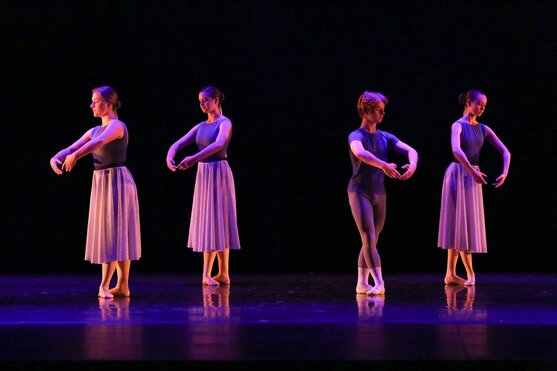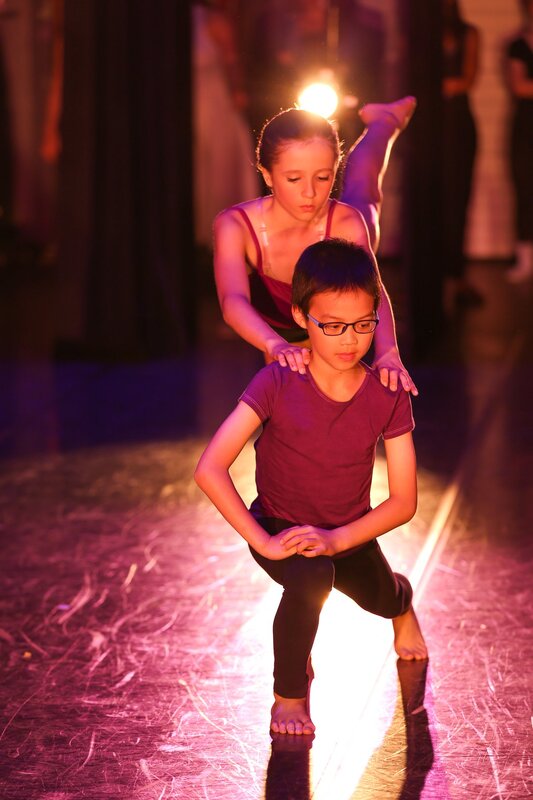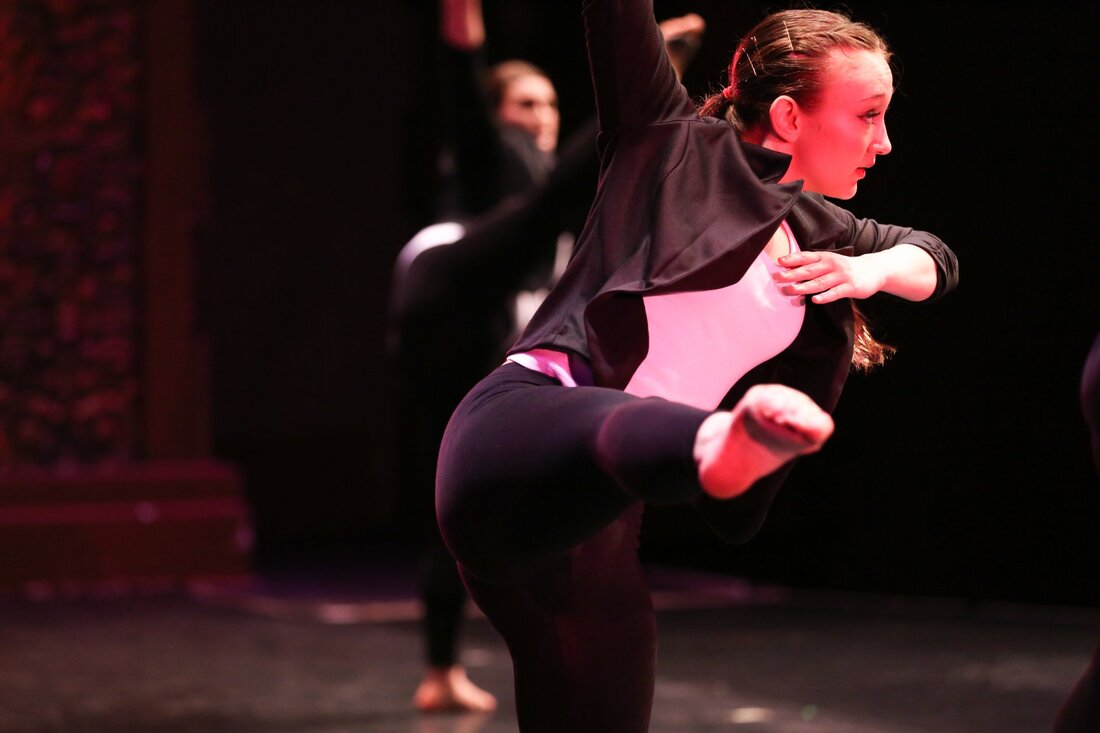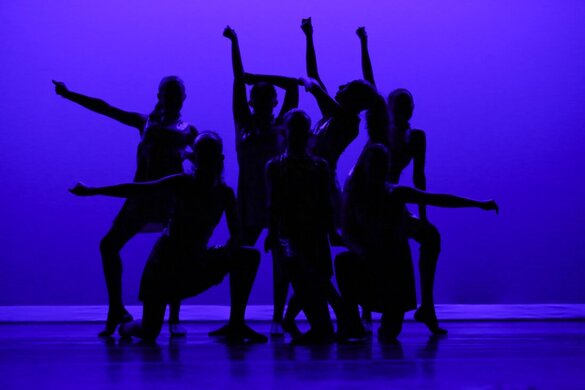Opus Dance Classes
OPUS encourages dancers of all ages and levels to reach their potential. Instructors are highly experienced, mature, knowledgeable, and are generous with encouragement. All classes focus on instilling a lifelong love of dance while addressing proper foundations and technique. OPUS students are given the tools needed to soar in their dancing! New students are invited to try their first class for free.
Levels
OPUS’ Artistic Director is happy to answer any questions or concerns you have about finding the proper level placement. Advancement among levels is at the teacher’s discretion and OPUS’ predetermined curriculum, not necessarily based on the dancer’s age. Students often repeat the same level for 1-2 years before moving on to the next level.
Levels
OPUS’ Artistic Director is happy to answer any questions or concerns you have about finding the proper level placement. Advancement among levels is at the teacher’s discretion and OPUS’ predetermined curriculum, not necessarily based on the dancer’s age. Students often repeat the same level for 1-2 years before moving on to the next level.
*** For dancers age 7 and under, please view our Opus For Kids page for compete information on Ballet/Tap Combo, Pre-Ballet, Primary Ballet, Teeny Hip Hop, and Tap I classes ***
Opus' Ballet Program
At the core of our dance program is ballet. A solid, strong foundation of ballet technique shapes a dancer in body and form. These classes are designed to give students a detailed knowledge of classical ballet, which includes technique, alignment, ballet history, terminology, musicality and artistic expression. Basic anatomy and kinesiology are also taught to develop students’ understanding of proper body mechanics.
|
Ballet I
Students are introduced to basic movement vocabulary and French terminology. The class will learn basic positions of the feet and arms through fundamental barre and center work. Students age 8 by December 31 of that calendar year may enroll directly into a once a week Ballet I-A class; Ballet I-B students are required to attend ballet classes 2 times per week. Students are also encouraged to take contemporary, jazz and/or hip hop dance classes to explore different dance styles. |
|
Ballet II
Building on Ballet I fundamentals, attention is paid to proper body alignment, use of the legs and feet, balance, more complex barre and center work with whole body coordination. Journaling is introduced as a tool to track goals. Ballet II students are required to attend ballet classes 2 times per week. Students are also encouraged to take contemporary, jazz and/or hip hop dance classes to explore different dance styles. |
|
Ballet III
Increased focus on cross-training and strengthening the core of the body is taught so that students maintain healthy physical progression through the levels, balanced muscles and the importance of self-care. More challenging ballet vocabulary is introduced as students develop coordination of arms and legs. Articulation and strength of the legs and feet with more advanced barre and center work. Petite allegro vocabulary is expanded with a greater emphasis on proper placement for jumps and landings as well as fundamentals for pirouettes. Journaling finishes every class to track our goals and progress. Students meet 3 times per week for ballet training and are strongly encouraged to take elective classes like contemporary, jazz, Master Classes from guest teachers and workshops when they are offered. At the teacher’s discretion, students may begin Pre-Pointe training. |
|
Ballet IV
Increased focus on cross-training and strengthening the core of the body is taught so that students maintain healthy physical progression through the levels balanced muscles and the importance of self-care. Expanded ballet vocabulary and added emphasis on artistry create a rigorous environment for students. More complex enchaînements, building foundations for multiple pirouettes, more complex coordination of the head and upper body, fluidity of port de bras and building on petite and grande allegro skills. Journaling finishes every class to track our goals and progress. Students meet 4 times per week for ballet training. Ballet IV+ are strongly encouraged to take elective classes like contemporary, jazz, Master Classes from guest teachers and workshops when they are offered. At the teacher’s discretion, students may take optional additional classes en pointe. |
|
Ballet V/VI
Expanded ballet vocabulary with an emphasis on advanced petite allegro and grand allegro skills. Ballet V/VI builds upon foundational skill with advanced variations of pirouettes, batterie, adagio and pas de valse. Working on the complexities of adding artistry with head and upper body movement, fluidity of port de bras and coordination of arms and legs with petite and grande allegro skills. Contemporary Ballet is explored to add new levels of versatility to classical ballet technique. Pointe students attend class en pointe to offer progress to their pointework. Journaling finishes every class to track our goals and progress. Students meet 4 times per week for ballet training. Ballet V+ are strongly encouraged to take elective classes like contemporary, jazz, Master Classes from guest teachers and workshops when they are offered. At the teacher’s discretion, students may take optional additional classes en pointe. |
Pre-Pointe
Students begin preparing the legs and feet for pointe work through a combination of Pre-Pointe appropriate exercises and ballet technique. Because pointe work is the cumulative result of gradual training of the whole body, readiness for pointe work is contingent upon many factors. Factors that determine pointe readiness include age, physical development, anatomical facility, strength of technique, length and frequency of study, attendance habits and maturity. Pre-Pointe will have an emphasis on articulation and strength of the legs and feet, students will work with therabands and other props to strengthen the appropriate muscles in the legs, feet, back, and abdominals to prepare students anatomically for the arduous work on pointe. Students must take a technique class prior to taking Pre-Pointe, so the muscles are warmed up and prepared for the intense work of these classes. Students, typically ages 11-13. To qualify, they must demonstrate solid technique and attend ballet at least three days a week. For more information, please see OPUS’ Pointe Policy.
Students begin preparing the legs and feet for pointe work through a combination of Pre-Pointe appropriate exercises and ballet technique. Because pointe work is the cumulative result of gradual training of the whole body, readiness for pointe work is contingent upon many factors. Factors that determine pointe readiness include age, physical development, anatomical facility, strength of technique, length and frequency of study, attendance habits and maturity. Pre-Pointe will have an emphasis on articulation and strength of the legs and feet, students will work with therabands and other props to strengthen the appropriate muscles in the legs, feet, back, and abdominals to prepare students anatomically for the arduous work on pointe. Students must take a technique class prior to taking Pre-Pointe, so the muscles are warmed up and prepared for the intense work of these classes. Students, typically ages 11-13. To qualify, they must demonstrate solid technique and attend ballet at least three days a week. For more information, please see OPUS’ Pointe Policy.
|
Pointe
Pointe work requires continuous and conscientious study to develop the correct musculature and strength. Because pointe work is the cumulative result of gradual training of the whole body, readiness for pointe work is contingent upon many factors. Factors that determine pointe readiness include age, physical development, anatomical facility, strength of technique, length and frequency of study, attendance habits and maturity. A pointe readiness evaluation is mandatory for students hoping to transition to pointe work and for students new to OPUS wanting to continue their pointe training. Core strength, range of motion, alignment, balance and foot strength are all included in our exam for being en pointe. Each student is assessed independently by the Artistic Director. Students must take a technique class prior to taking Pointe, so the muscles are warmed up and prepared for the intense work of these classes. For more information, please see OPUS’ Pointe Policy. |
|
Adult Drop-in Ballet:
Got a passion for ballet? It’s never too late to learn! Whether you’re returning to ballet, in search of more practice time and expert instruction or just starting off, OPUS offers a variety of adult classes to lead you through barre practice and center work focusing on proper form as you gradually build on your technique. As every dancer would agree, ballet takes repetition and practice. A challenge for the mind as well as body, ballet strengthens and tones while promoting good posture and cardiovascular health. OPUS offers foundational ballet, beginner, intermediate and open level ballet classes on a drop-in basis. |
- Foundational Ballet is suitable for students with zero to little ballet training or for more experienced students looking to refine their technique. Students are introduced to basic movement vocabulary and French terminology. The class will learn basic positions of the feet and arms through fundamental barre and center work. Attention is paid to proper body alignment, use of the legs and feet, balance, and whole body coordination.
- Beginner Ballet is suitable for the beginner teen/adult as well as students who would like to work in a slower paced environment. Attention is paid to proper body alignment, use of the legs and feet, and developing movement sequences through coordination of the arms and head. Students are encouraged to follow more experienced students as well as ask questions when needed.
- Intermediate/Open Ballet welcomes student’s teen/adult with at least 2 years of committed ballet training. Students attending this class are expected to know basic barre and center vocabulary as well as simple petite allegro, pirouettes, combinations from the corner and grand allegro. Like all of our open classes, this class is subject to the needs of the overall attendees of each class.
All adult classes are drop-in; complete information is on our adult dance class page.
Contemporary Levels I-IV
Contemporary class will work your brain, body, and artistic spirit. OPUS’ contemporary curriculum is based on fundamentals of modern dance and ballet technique, integrating strength-building, healthy alignment, and varied dance concepts to help students move with freedom, presence and confidence. Concepts of weight, energy, rhythm, and momentum are explored at the barre, on the floor, in improvisation and in choreographic phrases. Students are given imagery and tools for learning phrase work and inviting artistic expression.
|
Contemporary I
Alignment, strength building and body awareness are emphasized in a fun, interactive and exploratory environment. Students will focus on building foundations of rhythm, coordination, whole body engagement, introductory floorwork and creative expression. Concurrent enrollment in a ballet class is recommended. |
|
Contemporary II
More varied and challenging exercises are explored as students are guided to further understanding of anatomy and alignment. We explore moving bigger, with more clarity and more rhythmic accuracy. Students progress to longer and more technical phrases of movement, explore a wide range of movement qualities and are encouraged to make artistic choices in their dancing. Concurrent enrollment in a ballet class is strongly recommended. |
|
Contemporary III
Further refinement and specificity of technique is explored for dancers who show maturity and a thirst for challenge. Concepts of weight, resistance, release, suspension and momentum are explored, often using the floor, to expand the dancer’s toolbox and aid students in taking on more advanced phrases of choreography. Students are guided to become strong, aware and present dancers with clear body awareness, the courage to make artistic choices and improvisational confidence. Due to the athletic and technical demands of this level, concurrent enrollment in a ballet class is required. |
Jazz Levels I-III
These classes focus on traditional jazz vocabulary and various styles of jazz including broadway, commercial and jazz funk. Classes focus on developing strength, power, correct alignment, coordination, style and confidence. Students will gain a sense of individuality and originality and will develop the ability to move quickly and think fast. Jazz training helps develop dancers who are expressive, dynamic, musical and passionate. Jazz II and III classes include an optional, additional 30 minutes of Lyrical. Because jazz draws heavily from ballet technique and alignment, concurrent enrollment in a ballet class is recommended.
|
Jazz II/Lyrical
More challenging jazz vocabulary is introduced and combined into combinations that are dynamic, varied and fun. Students will hone basic turns, kicks, traveling steps, jumps and leaps. Rhythm, correct technique, clarity and strength are emphasized. Students will also be introduced to the flowing, expressive style of Lyrical. Due to the athletic nature and technical demands of this class, concurrent enrollment in a ballet class is highly recommended. |
|
Jazz III/Lyrical
Students will continue to build their vocabulary of turns and leaps while building their technique and athleticism. Students are guided to step beyond comfort zones and move with ever increasing levels of attack, confidence and artistry. Due to the athletic nature and technical demands of this class, concurrent enrollment in a ballet class is required. |
Tap Levels I-III

Tap I – Beginner
Students are introduced to basic movement vocabulary and tap terminology. The class will focus on solid technique while learning combinations and participating in improvisation. Special emphasis is given to rhythm training, including swing and straight time.
Students age 7 by December 31 of that calendar year may enroll directly into Tap I class. Students are also encouraged to consider tap dance like any instrument, where progress is achieved through dedicated practice at home. Basic Vocabulary: Toe, heel, dig, spank, scuff, hop, shuffle, flap, paddle and roll, cramp roll, clap
Tap II – Intermediate
Building on Tap I fundamentals, attention is given to relaxed and precise use of the body, balance, and more complex steps and combinations. Emphasis is given to developing the practice habits necessary to perform steps at increasing tempos. Journaling is introduced as a tool to track goals. Students are encouraged to consider tap dance like any instrument, where progress is achieved through dedicated practice at home. Intermediate Vocabulary: riff, time step, cincinnati, pickup, drag, open third, closed third, clap
Tap III – Advanced
Building on Tap II technique, attention is given to dynamics, musicality, and personal style. Emphasis is given to learning the tools to support learning and growth beyond the studio environment. Video journaling is introduced as a tool to track progress and goals. As always, students are encouraged to consider tap dance like any instrument, where progress is achieved through dedicated practice at home. Advanced Vocabulary: triple shuffle, wings, other vocabulary as needed to perform advanced choreography
Students are introduced to basic movement vocabulary and tap terminology. The class will focus on solid technique while learning combinations and participating in improvisation. Special emphasis is given to rhythm training, including swing and straight time.
Students age 7 by December 31 of that calendar year may enroll directly into Tap I class. Students are also encouraged to consider tap dance like any instrument, where progress is achieved through dedicated practice at home. Basic Vocabulary: Toe, heel, dig, spank, scuff, hop, shuffle, flap, paddle and roll, cramp roll, clap
Tap II – Intermediate
Building on Tap I fundamentals, attention is given to relaxed and precise use of the body, balance, and more complex steps and combinations. Emphasis is given to developing the practice habits necessary to perform steps at increasing tempos. Journaling is introduced as a tool to track goals. Students are encouraged to consider tap dance like any instrument, where progress is achieved through dedicated practice at home. Intermediate Vocabulary: riff, time step, cincinnati, pickup, drag, open third, closed third, clap
Tap III – Advanced
Building on Tap II technique, attention is given to dynamics, musicality, and personal style. Emphasis is given to learning the tools to support learning and growth beyond the studio environment. Video journaling is introduced as a tool to track progress and goals. As always, students are encouraged to consider tap dance like any instrument, where progress is achieved through dedicated practice at home. Advanced Vocabulary: triple shuffle, wings, other vocabulary as needed to perform advanced choreography
Hip Hop (Teeny 5-7, Children’s 8-10, Youth 10-13)
Private Classes
Private Lessons
Private Lessons give students the opportunity to work one-on-one with a professional instructor in an individual class carefully tailored to the needs of the student. Private lessons are available on an arranged basis. You may schedule privates for one session or for the entire year depending upon the objective.
Private lessons are offered at $60/hour
Semi-privates lessons of two students are offered at $40/hour per student
Private lessons require a 24-hour cancellation policy.
Private Lessons give students the opportunity to work one-on-one with a professional instructor in an individual class carefully tailored to the needs of the student. Private lessons are available on an arranged basis. You may schedule privates for one session or for the entire year depending upon the objective.
Private lessons are offered at $60/hour
Semi-privates lessons of two students are offered at $40/hour per student
Private lessons require a 24-hour cancellation policy.



















